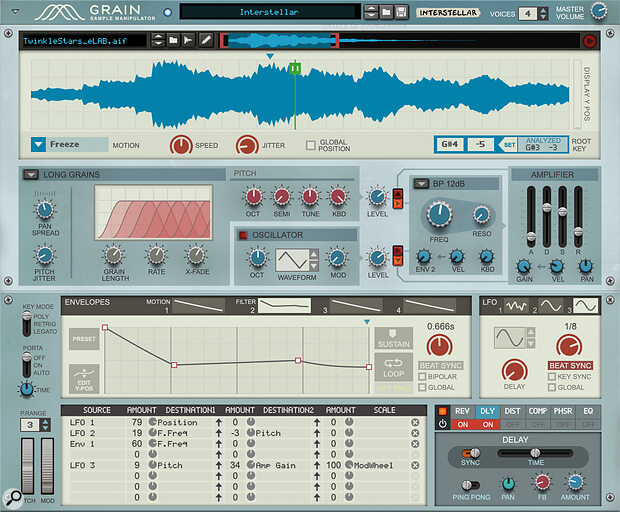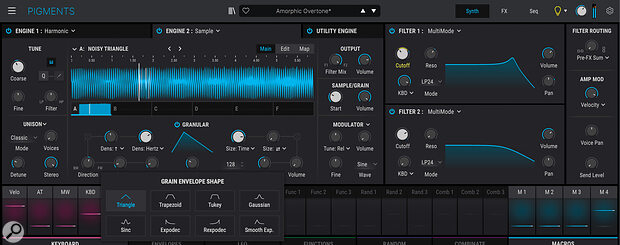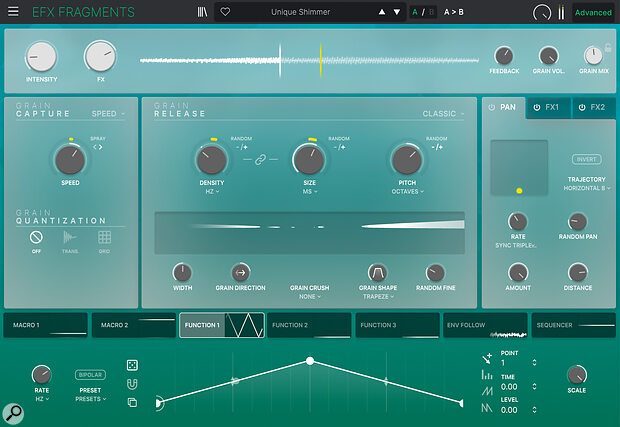 Granular synths come in lots of different shapes and sizes. In plug‑in form there can often be a distinction between true granular‑driven synths (as with Reason Studios’ Grain) and effects processors (like Output’s Portal). These two are sophisticated, complex tools capable of a vast range of effects.
Granular synths come in lots of different shapes and sizes. In plug‑in form there can often be a distinction between true granular‑driven synths (as with Reason Studios’ Grain) and effects processors (like Output’s Portal). These two are sophisticated, complex tools capable of a vast range of effects.
Once the preserve of academic and experimental music, granular synthesis is more accessible than ever and has a lot to offer in all sorts of genres.
Granular synthesis is full of creative potential, and the source of many musically useful sounds unachievable by other means. If you’re working in electronic, dance, experimental, alt rock and cinematic genres and you’re not using it... well, perhaps you could be!
The technique is all about splitting audio into small slices or ‘grains’, often just fractions of a second long, before later reconstituting them in a different way, possibly after they’ve undergone various transformations.
Grains can be derived from an audio sample, or extracted in real time from a track in your DAW or an incoming live audio signal. As such, granular tools often fall into two broad categories: synths, which are playable via MIDI, and processors that are essentially effects for your DAW, guitar pedalboard or Eurorack case.
What can you actually achieve with granular synthesis? It tends towards creating versions of your source material that are nebulous and cloudy, smeared and frozen, or fragmented and glitchy. However the effect can also be intensely rhythmic, pulsing and percussive too.
In this piece we’ll look at some of the practicalities and possibilities with granular, and round up the best tools out there.
Parameters & Possibilities
Like analogue (and virtual analogue) synths, there can be considerable variation in appearance of granular synthesizers and the terminology they use. In the end though they’re often underpinned by identical concepts. And if you grasp these, you’re well on your way to mastery of the technique, at least in the way it’s typically presented for music production.
I already mentioned that grains can be generated from a sample, or a live input buffer. Some live processors let you freeze the buffer, by the way, which gives you a sort of ‘temporary’ sample to work with.
So one of the first parameters to look for in a granular synth is Position (or a similar term). It sets the point at which grain extraction takes place. For a sample, that’ll be (to begin with at least) a single position within it. For a live input, it’ll be how far back in the sound’s ‘history’ the processor looks. Any granular synth that has a waveform display (eg. most software‑based options, and a few hardware units, like the Tasty Chips GR‑1) will show Position superimposed on the waveform.
 The Tasty Chips GR‑1 is a dedicated desktop granular synth.
The Tasty Chips GR‑1 is a dedicated desktop granular synth.
Amongst other things, when working with a sample, or a frozen input buffer, a static Position will let you generate sustaining timbres from percussive and discontinuous source material, and ‘explore’ it as if with a time‑based magnifying glass. Your sample becomes a sort of big, complex wavetable, yielding thousands of harmonic starting points: already a fascinating prospect.
It can be more interesting if the grain position moves. A small oscillation around a fixed point adds complexity and movement in the sound and helps avoid sterility or ringing artefacts. A dedicated parameter, variously called Jitter, Spray or similar, can often be found that does exactly this: if it’s not there the same might be achieved with random modulation from an onboard LFO.
What can you actually achieve with granular synthesis? It tends towards creating versions of your source material that are nebulous and cloudy, smeared and frozen, or fragmented and glitchy. However the effect can also be intensely rhythmic, pulsing and percussive too.
However, much larger ‘scans’ of playback position are possible too, that will potentially sweep (or jump discontinuously) through seconds or even minutes of audio. Manual movements are themselves fascinating, and if you’re using a plug‑in you can either do them with your mouse or by attaching a hardware MIDI controller to the parameter.
 One of the challenges of digging into granular synthesis, as opposed to just firing up presets, is mastering the terminology. On Mutable Instruments’ superb Beads ‘texture synthesizer’ the parameter often called ‘Position’ is instead ‘Time’. Others are more conventional.Otherwise, playback position is often best modulated by envelope generators and LFOs (or both), and some granular tools offer dedicated motion recorders, step sequencers and looping facilities for the job. This opens up possibilities for sounds that have attack portions that are conspicuously time‑stretched, that play backwards as well as forwards, or that pull rhythmic, percussive slices from original material that is sustaining. For MIDI or CV‑driven synths it often makes sense for position scans to be key‑sync’ed, so they trigger for every note you play. However, they needn’t be, which can make for a more fluid effect.
One of the challenges of digging into granular synthesis, as opposed to just firing up presets, is mastering the terminology. On Mutable Instruments’ superb Beads ‘texture synthesizer’ the parameter often called ‘Position’ is instead ‘Time’. Others are more conventional.Otherwise, playback position is often best modulated by envelope generators and LFOs (or both), and some granular tools offer dedicated motion recorders, step sequencers and looping facilities for the job. This opens up possibilities for sounds that have attack portions that are conspicuously time‑stretched, that play backwards as well as forwards, or that pull rhythmic, percussive slices from original material that is sustaining. For MIDI or CV‑driven synths it often makes sense for position scans to be key‑sync’ed, so they trigger for every note you play. However, they needn’t be, which can make for a more fluid effect.
Now we get to the heart of the matter. The Size (or length) of your grains, and the Density (or frequency/rate) at which they’re generated, has a huge bearing on the final effect. Some developers use an ‘Overlap’ parameter instead of Density, which performs a similar role. Size and Density are usually separately and smoothly variable, so all sorts of interactions are possible, but along the way a range of distinct effects emerge.
Small/short grains at low Density make for a sort of Geiger‑counter effect: discontinuous, glitchy spikes of sound. Increase the Density and you get a pointillist haze: often a weirdly transparent, emaciated version of the original material. Keep going and separate pitches or strange side‑bands can emerge.
With larger/longer grains the effect is much more fulsome, and more of the original material is heard. At low Density, you get separated little sections of sample replay. At high Densities dozens or hundreds of copies begin to overlap and the sound becomes smooth, blurred, and smeared. This, for many, is pretty much the main draw of granular synthesis: a source of rich, complex, somehow timeless textures that are well suited to textural backdrops, atmospheres and slow, playable pads.
 The interface of Output's Portal granular synthesizer.
The interface of Output's Portal granular synthesizer.
Granular Mastery
Good granular synths further nuance the effect of these Size/Density combos by allowing the parameters to be randomised or more fully modulated. Both introduce even greater movement and fluidity.
Crucially, though, an amplitude envelope can be imposed on every single generated grain: often called grain shape. Triangle or other smooth‑edged envelopes essentially impose hundreds of crossfades into the stream of grains for a buttery smooth effect. Shapes closer to square waves, with an instant‑on/off characteristic, are more punchy but have a potential for glitch artefacts: which could be entirely desirable, depending on what you’re going for. Downward ramp shapes, meanwhile, often make for sparkling, delicate timbres.
Going even further, you can often opt to have grains played forwards or backwards (which really does more with longer grain lengths), or both, and scattered across the stereo field.
Then there’s the fascinating matter of pitch. Small pitch fluctuations from grain to grain achieve a rich, detuned chorus. However, some granular synths can impose bigger, quantised pitch changes such as octave, interval or chord‑form transpositions. The potential opens up for shimmer‑like stacks, or harmonies generated from single‑pitch (or even unpitched) source material.
Actually there’s one practical aspect of pitch we haven’t considered yet. If you’re wanting to play a granular synth you’ll often want it in tune with your other more conventional synths and samplers. But this is to a large extent sample‑dependent, especially if your source sample is of a melody, say, that varies in pitch. Many good synths offer automatic root‑note detection and additional manual adjustability, which solves this problem.
But a different way to think about it is that you’re only ever really triggering replay, and it’ll be both Position (and other parameters), as well as your MIDI controller pitch, that determines the pitch of your source sample from moment to moment.
Indeed, many granular tools work at least as well as drone and texture generators that don’t require MIDI input at all: you literally ‘play’ them with their grain generation parameters. Harmonising that approach with DAW‑based work might be more about triggering granular sounds at the right moment, and letting automation take over. Or recording a real‑time jam and editing it in your DAW afterwards. Both need a different mindset to conventional synth playing but can be hugely creatively rewarding.
 Part of the user interface for Arturia’s Pigments. The granular oscillator type offers a vast array of grain shapes (the pop‑up at lower left) that can still be skewed. Pigments also has extensive randomisation options, of almost all its key parameters.
Part of the user interface for Arturia’s Pigments. The granular oscillator type offers a vast array of grain shapes (the pop‑up at lower left) that can still be skewed. Pigments also has extensive randomisation options, of almost all its key parameters.
What’s Worth Granulising?
Granular synthesis can generate sounds that have little in common with the audio from which the grains were produced. But that’s very different from saying that source material makes no difference: it really does.
In short, the best and most fruitful material to use as a starting point with granular synths is anything which includes movement and variation.
A single decaying strike, of a guitar or piano note, or a cymbal or gong, can contain a world of sonic potential. There can be wild, unexpected complexity in the first few milliseconds of attack, and perhaps a calmer beauty nearer the end of the decay. It works well to make samples including many different kinds of hit, giving you a bank of material to work from.
Variations in sustained timbre are also great to explore. For example, a heavily compressed overdriven guitar lead tone, with complex harmonics created by deliberately inducing feedback from an amp, can generate any number of amazing end‑points. Also sung notes, perhaps cycling through different vowel sounds, going in and out of sibilance, or deliberately activating nasal resonances.
Also try recording, with an instrument of your choice, all the main chords or notes used in a song you’re producing. This gives you a bank of relevant harmonies to work with, so you can manually overlay granular versions of them on conventionally recorded and performed tracks. If you deliberately overlap the chords or notes in your sample, either with long reverb tails or lingering synth/string pads, you’ll get regions of ‘in‑between’ harmonies to play with or scan through in the granular sphere.
Tools Of The Trade
There’s not enough room to go into all of these in detail, but here’s a rundown of some of the best options currently for exploring granular synthesis on computer, iPad, hardware and pedals.
Windows/Mac OS Software:
 Emergence, Daniel Gergely’s real‑time granulator plug‑in.Arturia currently offer two great granular tools. Their do‑anything Pigments synth has a granular section in its Sample engine that will do pretty much anything you could need it to. For granular effects, Fragments is superb. Its unique abilities include quantisation of grain ‘capture’ to transients, and three different ‘release’ engines tailored to multi‑layered nebulous textures, tight rhythmic effects, and more conventional timbres.
Emergence, Daniel Gergely’s real‑time granulator plug‑in.Arturia currently offer two great granular tools. Their do‑anything Pigments synth has a granular section in its Sample engine that will do pretty much anything you could need it to. For granular effects, Fragments is superb. Its unique abilities include quantisation of grain ‘capture’ to transients, and three different ‘release’ engines tailored to multi‑layered nebulous textures, tight rhythmic effects, and more conventional timbres.- An alternative synth option is Audio Damage’s Quanta 2: a really fully featured instrument with additional VA oscillators, MPE support and much more. And another potent effect processor is Output’s Portal, which has extensive macro functionality and often a flavour of a really otherworldly delay/reverb.
- Bubbler is by Tom Erbe, the hugely experienced computer researcher whose algorithms are used in several Make Noise Eurorack modules. It’s a really useful granular cloud generator, with shimmer tendencies, and it’s free: www.soundhack.com/freeware
- Emergence, a donationware plug‑in from www.daniel-gergely.itch.io/emergence is a superb tool, with four independent grain streams, pitch quantisation, and extensive LFO, randomisation and macro modulation.
DAW‑bundled Mac OS/Windows Software:
- Alchemy, part of Logic Pro since 2015, has a great granular mode that works with imported samples.
- Grain, in Reason 12 (and any DAW of your choice of course, thanks to Reason’s availability nowadays as a VST3 plug‑in), is a fascinating and rather unique granular synth with three separate granular algorithms offering classic timbres, wavetable‑like operation, and a kind of spectral resynthesis mode.
iOS Software:
 Chris Carlson’s Borderlands Granular for iPad has a unique tactile interface.Stunning in its conception, and quite magical in use, is Borderlands: a granular synth you play using a unique graphical interface with multiple (and sometimes overlapping) audio regions and ‘grain cloud’ generators.
Chris Carlson’s Borderlands Granular for iPad has a unique tactile interface.Stunning in its conception, and quite magical in use, is Borderlands: a granular synth you play using a unique graphical interface with multiple (and sometimes overlapping) audio regions and ‘grain cloud’ generators.- A more conventional playable synth is the iPadOS version of Quanta, that I’ve mentioned already.
- Tardigrain is a really affordable option: its grain controls are unusual, with no specific Position parameter, but it’s capable of beautiful sounds.
- iDensity is impressive, but perhaps not the best beginner’s option.
Stand‑alone Hardware & Eurorack:
- The standout hardware granular synth is GR‑1 by Tasty Chips, playable as a multitimbral drone machine and via MIDI. The big display and dedicated parameter controls add hugely to the responsiveness, and sonically it’s capable of notably dense, smooth timbres, with really sophisticated looping and tempo‑sync options.
- Granular oscillators are available in the Waldorf Quantum and Iridium synths, supported by a superb display and hardware control system. In raw granular clout they can’t match the GR‑1, but as part of a more sophisticated system, with filters, effects and other types of synthesis around, that could be a moot point.
- For two different flavours of hardware granular effects, both delicious, try Hologram’s Microcosm pedal and the Red Panda Particle 2.
- Finally, in the Eurorack world, Mutable Instruments’ Clouds, and its more recent replacement Beads, are classics, working just as well as effects as they do granular oscillators. Also look at Noise Engineering’s Melotus Versio, Qu‑Bit’s Nebulae, and Instruo’s Arbhar, which uniquely has a mic built into its front panel.
Some History
We might assume granular synthesis is an exclusively digital technique, but amazingly its first appearance was in analogue, tape‑based form in the composition ‘Analogique B’ by Greek composer Xenakis. To hear it, by the way, you’re sometimes better off searching for ‘Analogique A’, an earlier chance‑based composition for strings that was later revised to include the electronic textures.
More development came in the ’70s and ’80s, with Barry Truax’s 1986 ‘Riverrun’ acknowledged as the first real‑time generated granular work. This used a custom‑built DMX‑1000 signal processing unit which could generate over 2000 grains per second, controlled by a separate microcomputer and Truax’s own software capable of parameter automation. Interestingly, the source material in 1986 was all simple waveforms, although Truax went on to also utilise FM‑generated sounds: granular synthesis from samples was still a way off in terms of processing power. There’s more information and some links to a couple of fascinating videos here: www.sfu.ca/~truax/river.html. A full version of ‘Riverrun’ is available to hear (and see) here: www.youtube.com/watch?v=u81IGEFt7dM
Tempo Sync’ing
I could happily watch (no, make that have happily watched) many hours go by just blasting random bits of samples into big, beautiful granular clouds. But another thing I really love to do with granular synths is to utilise tempo‑sync’ed options, when they’re offered.
For example, a software, DAW‑hosted granular synth’s Density parameter can often be switched from using units of Hz (ie. number of grains per second) to various musical values. Work with a sample of slowly‑varying synth noise (or crashing waves, or a boiling kettle), scan through it slowly, spit out short sawtooth‑shaped grains with a density of 1/16th notes, and you instantly have a hi‑hat part that has both machine‑like precision and ever‑changing timbral variation.
Another similar approach is to run an existing DAW track — perhaps a drum mix, vocal or rhythmic guitar part — through a granular processor that has its buffer read position and grain length parameter time‑sync’ed. With continual variation of density, shape, perhaps also playback direction, and wet/dry mix, you can achieve a delay‑like overlay but one that has far more motion and variation than a typical delay. It can act as a really fascinating and arresting decoration, peppering the original material or momentarily replacing it.

